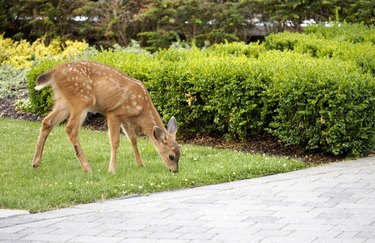
As most gardeners know, deer eat almost anything. Very few trees or other plants can be called deer-proof or deer-resistant. Daylilies (Hemerocallis spp., USDA zones 3-10) are appealing to deer, which have been known to munch on daylily blooms and even eat the leaf shoots all the way to the ground. Luckily, established daylilies have extensive root systems that help them survive even the most severe damage from deer. Although you might not be able to enjoy blooms on your deer-eaten daylilies this year, you at least know your plants probably will live.
The Deer-Resistant Stella de Oro Daylily
Video of the Day
There is hope for daylily lovers in areas with deer. The Stella de Oro daylily (Hemerocallis Stella de Oro') has been bred to be deer-resistant. The cultivar is perennial in U.S. Department of Agriculture plant hardiness zones 3 through 10 and is a repeat bloomer, providing golden yellow, trumpet-shaped flowers from early summer to mid-fall. Almost no plant is completely deer-resistant, however, and deer may nibble on this daylily after a hard winter out of desperation. Like humans, deer are attracted to food sources that they find tasty. After other treats grow, they may leave the daylilies alone for better fare.
Video of the Day
Planting Techniques
One way to protect your prized daylilies from becoming snacks for deer -- and to enjoy their blooms all summer -- is to surround the daylilies with plants that are deer-resistant. The time spent planning your deer-resistant flower border will be well worth the effort when your daylilies are left alone by deer. Certain shrubs, trees, herbaceous perennial plants and annual plants are not usually damaged by deer. Deer do not like plants with strong, fragrant scents. The scents distract from smelling potential danger or threats. Herbs like sage (Salvia officinalis, USDA zones 4-8) and lavender (Lavandula spp., USDA zones 5-8, depending on species and cultivar), and flowers like peonies (Paeonia spp., USDA zones 3-8, depending on species and cultivar) are too smelly for deer. They will also avoid poisonous plants like daffodils (Narcissus group, USDA zones 4-8) and poppies (Papaver spp., USDA zones 3-10, depending on species and cultivar).
Deer Repellents
Another way to attempt to keep your daylilies from becoming the deer's next meal is to use repellents. For example, bar soap and hair are both deer repellents.
The scent of soap seems to keep deer away. Soap that has an especially strong, soapy aroma works best. Stab bars of soap with a sharp stick, and set the bars around your garden, or hang them in mesh bags around the garden.
When you clean your hairbrush, save the hair you remove from it. Likewise, save the fur from your dog's or cat's brush. Put the hair and/or fur in mesh bags and hang the bags around your garden. The scent of the human hair and/or animal fur may scare off deer.
Many commercial deer repellents are available, and they contain items ranging from rotten egg solids to fungicides. If you choose to use a commercial repellent, then read and follow all of its directions carefully. Most commercial repellents need to be sprayed directly on plants to deter deer from eating the vegetation. Some repellents need to be reapplied after a rain, and all need to be applied on new growth as it appears.
Deer Deterrents
The best way to keep your daylilies safe from being eaten by deer is to keep deer away from the plants completely. Two strategies to try are fencing and scare tactics.
Whether it's a wooden privacy fence, mesh deer netting or an electric fence, a border around your garden can protect it. Some deer can jump up to 8 feet high, so your fence needs to be at least that tall. Even though deer can jump 8 feet upward, they cannot jump over a wide object that is 8 feet tall. Therefore, your fence could be 6 feet tall if its top portion above 6 feet slants outward at a 45-degree angle.
If you're not ready to dedicate yourself to fencing, then try some other ways to keep deer away from your daylily garden. For example, the mere presence of dogs protects plants. A motion-activated sprinkler deters deer. Also, a radio playing loudly in the garden will keep deer away, but it may disturb neighbors.